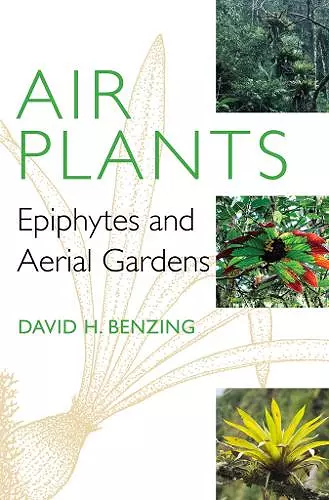Air Plants
Epiphytes and Aerial Gardens
Format:Hardback
Publisher:Cornell University Press
Published:15th Jun '12
Should be back in stock very soon

Often growing far above the ground, "air plants" (or epiphytes) defy many of our common perceptions about plants. The majority use their roots only for attachment in the crowns of larger, usually woody plants—or to objects such as rocks and buildings—and derive moisture and nutrients from the atmosphere and by collecting falling debris. Only the mistletoes are true parasites. Epiphytes are not anomalies and there are approximately 28,000 species—about 10 percent of the higher or vascular plants—that grow this way. Many popular houseplants, including numerous aroids, bromeliads, ferns, and orchids, rank among the most familiar examples. In Air Plants, David H. Benzing takes a reader on a tour of the many taxonomic groups to which the epiphytes belong and explains in nontechnical language the anatomical and physiological adaptations that allow these plants to conserve water, thrive without the benefit of soil, and engage in unusual relationships with animals such as frogs and ants.
Benzing's comprehensive account covers topics including ecology, evolution, photosynthesis and water relations, mineral nutrition, reproduction, and the nature of the forest canopy as habitat for the free-living and parasitic epiphytes. It also pays special attention to important phenomena such as adaptive trade-offs and leaf economics. Drawing on the author's deep experience with epiphytes and the latest scientific research, this book is accessible to readers unfamiliar with technical botany; it features a lavish illustration program, references, a glossary, and tables.
Benzing's love for epiphytes is clearly evident, and the book provides an excellent introduction to the field.... By starting from first principles, it provides a tidy introduction to field botany to an undergraduate audience.... All the basic principles of botany are covered using epiphytes as model organisms.... The systematic overview of epiphyte diversity in particular provides an important, holistic grounding in epiphyte taxonomy, biogeography, and systematics.... There is something in it for everyone, from newcomers to plant biology to those who regularly climb trees to do their research.
-- K. C. Burns * Ecology *David Benzing's exuberance is evident throughout this book. His love of epiphytes... captivates the reader.... Benzing’s is a well-conceived and well-executed testimony to epiphytes and serves to bring together up-to-date information about these not very well understood plants. It provides a basis for further inquiry to round out our understanding of this peculiar life style of plants and points out areas where further study would be productive.
-- William Stern * Plant Science Bulletin *Modest in size, but not in content and scope, Benzing's pithy gem of a synthesis appears 22 years after his technical monograph, Vascular Epiphytes (1990).... Summing Up: Highly recommended.
-- R. Schmid * ChoiISBN: 9780801450433
Dimensions: unknown
Weight: 907g
256 pages